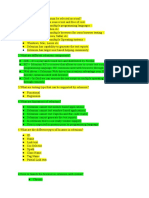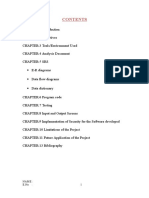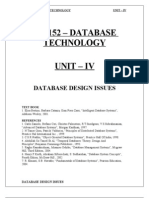OOP - Programming Paradigm Based Concept of Objects
OOP - Programming Paradigm Based Concept of Objects
Uploaded by
mikemelanceCopyright:
Available Formats
OOP - Programming Paradigm Based Concept of Objects
OOP - Programming Paradigm Based Concept of Objects
Uploaded by
mikemelanceOriginal Description:
Original Title
Copyright
Available Formats
Share this document
Did you find this document useful?
Is this content inappropriate?
Copyright:
Available Formats
OOP - Programming Paradigm Based Concept of Objects
OOP - Programming Paradigm Based Concept of Objects
Uploaded by
mikemelanceCopyright:
Available Formats
OOP – Programming Paradigm based concept of objects
Classes are templates used in object-oriented programming to create objects, which are instances of that class.
Object is an instance of a class that defines what property, variable or functions of the class.
If the class instantiated it’s called object
No need to declare or to define over and over again
Inheritance – Sharing of Information (Extend all properties, functions, methods etc. from parent class to child class)
Encapsulation – Grouping of information (All functions and characteristics are related to the class)
Abstraction – Hiding of information (Hiding certain details and showing only essential info to the users)
Polymorphism – Redefining of Information (Overriding the methods of the child class of her parent class)
Public and Private is Access Modifier.
LARAVEL
Installation
PHP Composer – Node.Js – Xampp with PHP > 7.2
- composer global require Laravel/installer
- Laravel new .
Resources -> Views -> welcome.blade.php
App -> Providers -> User.php (Model)
App -> Http -> Controllers -> controller.php
Route ->
Database configuration -> .env file
Xampp – Apache – config – config.inc.php -> auth_type = cookie
Artisan is a console or command line of Laravel
Php artisan serve
Npm install
Npm run dev = compile the projects
Php artisan migrate
Composer require laravel/ui
Php artisan ui vue –auth
Php artisan migrate
Php artisan serve
Npm run dev
Php artisan migrate:fresh
Php artisan make: controller
Dd($user) = Die and Dump
Middleware – methods that required login before access dashboard
Laravel includes a middleware that verifies whether the user of the application is authenticated or not.
Postman = tool for verifying API and interact with HTTP API
Get = request method to get general information to the server
Post = request method that used when we need to send additional information
Put = request method where the client sends data that updates the entire resources
Patch = request method where the client sends data that updates the partial resources
Delete = request method where the client needs to remove the entire resources
Symfony root PHP Framework
Laravel is PHP Framework
Benefits of Laravel
- Template Tools
- Authentication and Authorization
- Inbuilt Libraries
- URL Generations
- MVC Architecture Support
- Artisan Tool Command Line
Separate into 3 major components
Model – Data related Logic that interact with the database.
View – UI logic for Users view.
Controller – Acts as interface between Model and View Components.
sa Laravel kasi pede ka na mag gawa ng table or fields then using yun build id structure na pag create field sa table ng
database... pede na gawin using yun laravel migration.. na hindi na pupunta sa table at dun mag lalagay ng fields or mag
add ka pa ng bagong table
Eloquent
Public function users()
return $this->hasMany(User::class, 'user_id', '_id');
Query Builder:
SELECT id, fname, lname, work_id work.name FROM user
OUTER JOIN work ON work.id = user.work_id;
Eloquent query in a OOP manner easy to use than query builder.
1. Queries are highly readable while written using Eloquent comparing with Query Builder.
2. You can use methods, scopes, accessors, modifier etc inside of a Model which is easy to maintain.
Since tokens are generally used in API authentication,
Laravel Passport provides an easy and secure way to implement token authorization on an OAuth 2.0 server.
How to call and fetch data from database to Vue?
Most of the time kasi ang mostly nagagamit dyan kay Vue for fetching data, through HTTP Request
from frontend to backend is Axios. Axios is an HTTP Framework.
JSON Web Token (JWT) is an open standard that allows two parties to securely send data and information as
JSON objects. This information can be verified and trusted because it is digitally signed. JWT
authentication has aided the wider adoption of stateless API services.
JWT is a token format. OAuth is an authorization protocol that can use JWT as a token.
Since HTTP driven applications are stateless, sessions provide a way to store information about the user across
requests.
You might also like
- Blockchain API Documentation 1 - BlockchairDocument173 pagesBlockchain API Documentation 1 - Blockchairbweaver700100% (2)
- Amdocs Clarify CRM DocumentationDocument17 pagesAmdocs Clarify CRM DocumentationVenkata KandulaNo ratings yet
- Practical File SQL Queries & DBMSDocument24 pagesPractical File SQL Queries & DBMSPabhat Kumar71% (28)
- Python Project Final Report On Book Management SystemDocument16 pagesPython Project Final Report On Book Management SystemAmogh Varshney100% (2)
- 92%-UGRD-ITE6200 Application Development and Emerging TechnologyDocument9 pages92%-UGRD-ITE6200 Application Development and Emerging Technologymichael sevillaNo ratings yet
- Real Time Selenium Int QueDocument28 pagesReal Time Selenium Int QueSathiya NarayananNo ratings yet
- Application Development and Emerging TechnologyDocument17 pagesApplication Development and Emerging TechnologyMichalcova Realisan Jezza100% (1)
- CC ($CC) True: Subject ($subject)Document5 pagesCC ($CC) True: Subject ($subject)Ven Ven100% (1)
- Personality Test - Result - AbeDocument6 pagesPersonality Test - Result - AbemikemelanceNo ratings yet
- Interview QuestionsDocument9 pagesInterview QuestionsAshoka SamratNo ratings yet
- Laravel Application Development 2021 - 1 - CSC - 006 - SubeczDocument8 pagesLaravel Application Development 2021 - 1 - CSC - 006 - Subeczblank anonimNo ratings yet
- 5 - PHP Framework Part 1-MTDDocument35 pages5 - PHP Framework Part 1-MTDRIFQAH AMALIYAHNo ratings yet
- How To Create A Secure CRUD RESTful API in Laravel 8 and 7 Using Laravel Passport - DEV CommunityDocument26 pagesHow To Create A Secure CRUD RESTful API in Laravel 8 and 7 Using Laravel Passport - DEV CommunityAntonius AjalahNo ratings yet
- Application Development and Emerging Technology Source 43512Document30 pagesApplication Development and Emerging Technology Source 43512John Llucastre Cortez0% (1)
- Distributed Object System: Java - Remote Method Invocation (RMI) Remote Method Invocation (RMI)Document22 pagesDistributed Object System: Java - Remote Method Invocation (RMI) Remote Method Invocation (RMI)endaleNo ratings yet
- Slide OpenSourceDocument21 pagesSlide OpenSourceHoàng Anh TrầnNo ratings yet
- User Authentication With Laravel - Laravel BookDocument9 pagesUser Authentication With Laravel - Laravel BookharadhonNo ratings yet
- College Management SystemDocument39 pagesCollege Management SystemdaffoNo ratings yet
- Recap: Value Types Reference Types String TypeDocument42 pagesRecap: Value Types Reference Types String TypeВук ИсићNo ratings yet
- Difference Between Sendredirect and Forward Servlet ApiDocument6 pagesDifference Between Sendredirect and Forward Servlet ApiaymanNo ratings yet
- Laravel API Tutorial - Building & Testing A RESTful API - ToptalDocument28 pagesLaravel API Tutorial - Building & Testing A RESTful API - ToptalMisbah AnsoriNo ratings yet
- Interview QuestionsDocument7 pagesInterview Questionssudershan dolliNo ratings yet
- OAF Introduction: Learn Share ConnectDocument17 pagesOAF Introduction: Learn Share Connectshyam123gNo ratings yet
- Servlets Training Session, CGI, Hyderabad Date: 14 MAR 2011 - 15 MAR 2011Document33 pagesServlets Training Session, CGI, Hyderabad Date: 14 MAR 2011 - 15 MAR 2011tmhNo ratings yet
- Selenium IQDocument14 pagesSelenium IQAvi GuptaNo ratings yet
- CS615 Lab5 Ata GunayDocument7 pagesCS615 Lab5 Ata GunayAta GünayNo ratings yet
- Application Development. It Has Rich and Reusable Libraries and Class For Your Website's FoundationDocument9 pagesApplication Development. It Has Rich and Reusable Libraries and Class For Your Website's FoundationVanessa Siano TangonanNo ratings yet
- CS506 Solved Subjective Final Term by JunaidDocument49 pagesCS506 Solved Subjective Final Term by JunaidAqsa NawazNo ratings yet
- Node JSDocument10 pagesNode JSSana Fathima SanaNo ratings yet
- Table of Content: Days Required TopicDocument10 pagesTable of Content: Days Required TopicSkinny KittenNo ratings yet
- CCS375 WT QBDocument5 pagesCCS375 WT QBpaulrajNo ratings yet
- Module 5 - LaravelDocument15 pagesModule 5 - LaravelMerlin MathewNo ratings yet
- Chapter FiveDocument24 pagesChapter Fivekaleb123 shumu12No ratings yet
- Spring MVCDocument27 pagesSpring MVCBikram KCNo ratings yet
- AppDev PDFDocument121 pagesAppDev PDFjikjik50% (2)
- Interview QuestionsDocument7 pagesInterview QuestionsanjibabuNo ratings yet
- Jee Q Ans Unit IDocument10 pagesJee Q Ans Unit Iriaz ahamedNo ratings yet
- Cs506 Final Term Solved Subjective by JunaidDocument37 pagesCs506 Final Term Solved Subjective by JunaidKhadija Afzal100% (2)
- Basic API Testing (Postman)Document11 pagesBasic API Testing (Postman)reshmashaik4656No ratings yet
- PHP Interview Questions - 001Document13 pagesPHP Interview Questions - 001SaiKiran TanikantiNo ratings yet
- Spring MVC Final BestDocument28 pagesSpring MVC Final BestTran Bao LongNo ratings yet
- E LearningDocument135 pagesE LearningPramod KumarNo ratings yet
- Spring BootDocument2 pagesSpring Bootroyalsubha123No ratings yet
- JavaaaDocument5 pagesJavaaa20BCA1109 Shivam SinghNo ratings yet
- Option D Study GuideDocument32 pagesOption D Study GuidelietuvossavivaldybeNo ratings yet
- CiginityDocument4 pagesCiginitySridhar SidNo ratings yet
- PPFSD - Question - Bank Answers NewDocument61 pagesPPFSD - Question - Bank Answers NewHell GamingNo ratings yet
- List Any Four Advantages of PHP ?Document15 pagesList Any Four Advantages of PHP ?Tanmay GoreNo ratings yet
- Basic Java Interview QuestionsDocument37 pagesBasic Java Interview QuestionsSaravana NatarajanNo ratings yet
- GMR Institute of Technology Rajam, AP: GMRIT/ADM/F-44 REV.: 00Document8 pagesGMR Institute of Technology Rajam, AP: GMRIT/ADM/F-44 REV.: 00rahulnakka74No ratings yet
- Serv LetDocument56 pagesServ LetAmar PatelNo ratings yet
- Laravel Interview Questions and AnswersDocument9 pagesLaravel Interview Questions and AnswersdevquoraNo ratings yet
- GCarrillo A Framework For The Development of Web Applications in PHPDocument8 pagesGCarrillo A Framework For The Development of Web Applications in PHPGabriel CarrilloNo ratings yet
- Intervw QuesDocument10 pagesIntervw Quesjohn boltNo ratings yet
- FSD 1Document16 pagesFSD 1777kenadam777No ratings yet
- Chronological Report of 6 Months Industrial Training: TH THDocument6 pagesChronological Report of 6 Months Industrial Training: TH THShane OrijaNo ratings yet
- Set 3Document12 pagesSet 3Roger kujurNo ratings yet
- Interview Salesforce QuestionDocument8 pagesInterview Salesforce QuestionjackndsNo ratings yet
- Florin Olariu: "Alexandru Ioan Cuza", University of Iași Department of Computer ScienceDocument45 pagesFlorin Olariu: "Alexandru Ioan Cuza", University of Iași Department of Computer ScienceGigi FloricaNo ratings yet
- PHP ImpDocument7 pagesPHP ImpVaishnavi JadhavNo ratings yet
- Mirpur University of Science and Technology: Department Software EngineeringDocument16 pagesMirpur University of Science and Technology: Department Software EngineeringBilalazamNo ratings yet
- Mule 4 Developer Cook Book For Beginners 2021Document70 pagesMule 4 Developer Cook Book For Beginners 2021bongidala1No ratings yet
- Puppet 5 Beginner's Guide - Third Edition: Go from newbie to pro with Puppet 5From EverandPuppet 5 Beginner's Guide - Third Edition: Go from newbie to pro with Puppet 5Rating: 4 out of 5 stars4/5 (1)
- PDFsam Merge PDFDocument6 pagesPDFsam Merge PDFmikemelanceNo ratings yet
- Covid 19Document191 pagesCovid 19mikemelanceNo ratings yet
- Application Form ABEDocument5 pagesApplication Form ABEmikemelanceNo ratings yet
- Tasks and Procedures: Task Activity ProcedureDocument1 pageTasks and Procedures: Task Activity ProceduremikemelanceNo ratings yet
- Days Date Login Logout # of Hours Per DayDocument1 pageDays Date Login Logout # of Hours Per DaymikemelanceNo ratings yet
- What Is FitnessDocument1 pageWhat Is FitnessmikemelanceNo ratings yet
- Table of Content: Pinocchio 2 - 3Document11 pagesTable of Content: Pinocchio 2 - 3mikemelanceNo ratings yet
- 5-Practicas+BigData Trabajar HdfsDocument10 pages5-Practicas+BigData Trabajar HdfsChristiam NiñoNo ratings yet
- Cs9152 DBT Unit IV NotesDocument61 pagesCs9152 DBT Unit IV NotesHema Latha100% (5)
- Rule Based System - RETE AlgorithmDocument32 pagesRule Based System - RETE AlgorithmarunNo ratings yet
- Cache ManagementDocument38 pagesCache ManagementRight BrainNo ratings yet
- Multi-Layout Invoice Document Dataset (MIDD) : A Dataset For Named Entity RecognitionDocument10 pagesMulti-Layout Invoice Document Dataset (MIDD) : A Dataset For Named Entity RecognitionViraj SolankiNo ratings yet
- Nonparametric Methods: Analysis of Ordinal DataDocument38 pagesNonparametric Methods: Analysis of Ordinal DataRadityaNo ratings yet
- SAP HANA Data Management and Performance On IBM Power Systems PDFDocument76 pagesSAP HANA Data Management and Performance On IBM Power Systems PDFVinaykumar PJNo ratings yet
- Geospatial-Temporal Analysis Andclassification of Criminal Data in ManilaDocument6 pagesGeospatial-Temporal Analysis Andclassification of Criminal Data in ManilaFarrukh HabibNo ratings yet
- R12Document5 pagesR12HammerNo ratings yet
- Mysql Shell 9.0 Relnotes En.a4Document8 pagesMysql Shell 9.0 Relnotes En.a4PC VarmaNo ratings yet
- Forms Dev NotesDocument19 pagesForms Dev NotesAvanish Kumar SinghNo ratings yet
- Afrinic Whois Database: Accuracy ReportDocument50 pagesAfrinic Whois Database: Accuracy ReportgardencityemartNo ratings yet
- Assignment 0.2: Description of The ProgramDocument7 pagesAssignment 0.2: Description of The ProgramBhavesh SoodNo ratings yet
- How To Make A Report in ArcgisproDocument5 pagesHow To Make A Report in Arcgisproapi-544040551No ratings yet
- EsclamadaDocument2 pagesEsclamadaHazel Jane EsclamadaNo ratings yet
- Unit - 3: Data Management IssuesDocument8 pagesUnit - 3: Data Management IssuessirqaimNo ratings yet
- FactoryTalk VantagePoint EMI Server - 8.40.00 (Released 11 - 2022)Document15 pagesFactoryTalk VantagePoint EMI Server - 8.40.00 (Released 11 - 2022)KronozZumayaNo ratings yet
- Trino (Presto) DB: Zero Copy Lakehouse: Artem Aliev HuaweiDocument45 pagesTrino (Presto) DB: Zero Copy Lakehouse: Artem Aliev HuaweiRicardo Carlini SperandioNo ratings yet
- Aplikasi Mantra - Kahar Akeb MuzaqarDocument10 pagesAplikasi Mantra - Kahar Akeb MuzaqaradityaNo ratings yet
- OpenText Vendor Invoice Management For SAP Solutions 7.5 SP9 - Scenario Guide English (VIME070509-CCS-EN-01)Document228 pagesOpenText Vendor Invoice Management For SAP Solutions 7.5 SP9 - Scenario Guide English (VIME070509-CCS-EN-01)Ashutosh JhaNo ratings yet
- Building Semantic Models Oracle Analytics CloudDocument258 pagesBuilding Semantic Models Oracle Analytics CloudsmreddyNo ratings yet
- Title: Library Management SystemDocument74 pagesTitle: Library Management SystemNakhabala MauriceNo ratings yet
- Grade 11 Unit 3 DatabaseDocument49 pagesGrade 11 Unit 3 Databasegaredew32No ratings yet
- Power QueryDocument14 pagesPower QueryYoussefNo ratings yet
- Department of Computer Science and Engineering (20Cs201) Database Management Systems Module Bank - 1Document7 pagesDepartment of Computer Science and Engineering (20Cs201) Database Management Systems Module Bank - 1Fake KingNo ratings yet
- Ganit - Data Analyst - JDDocument1 pageGanit - Data Analyst - JDKingshuk MukherjeeNo ratings yet

































































































